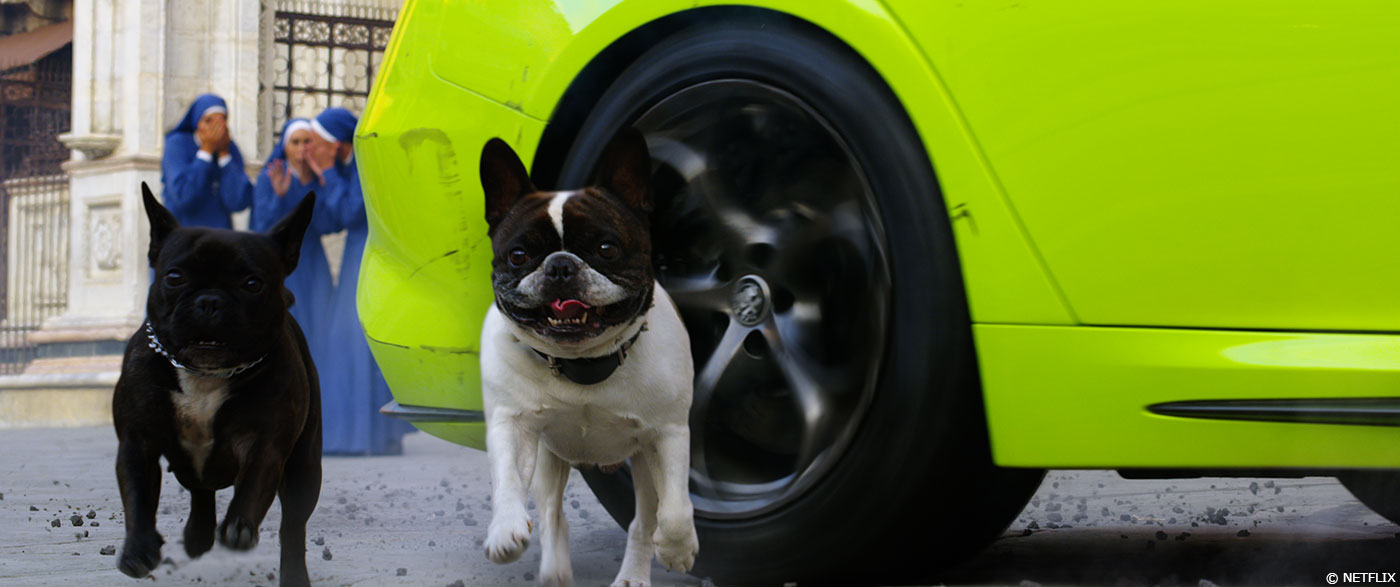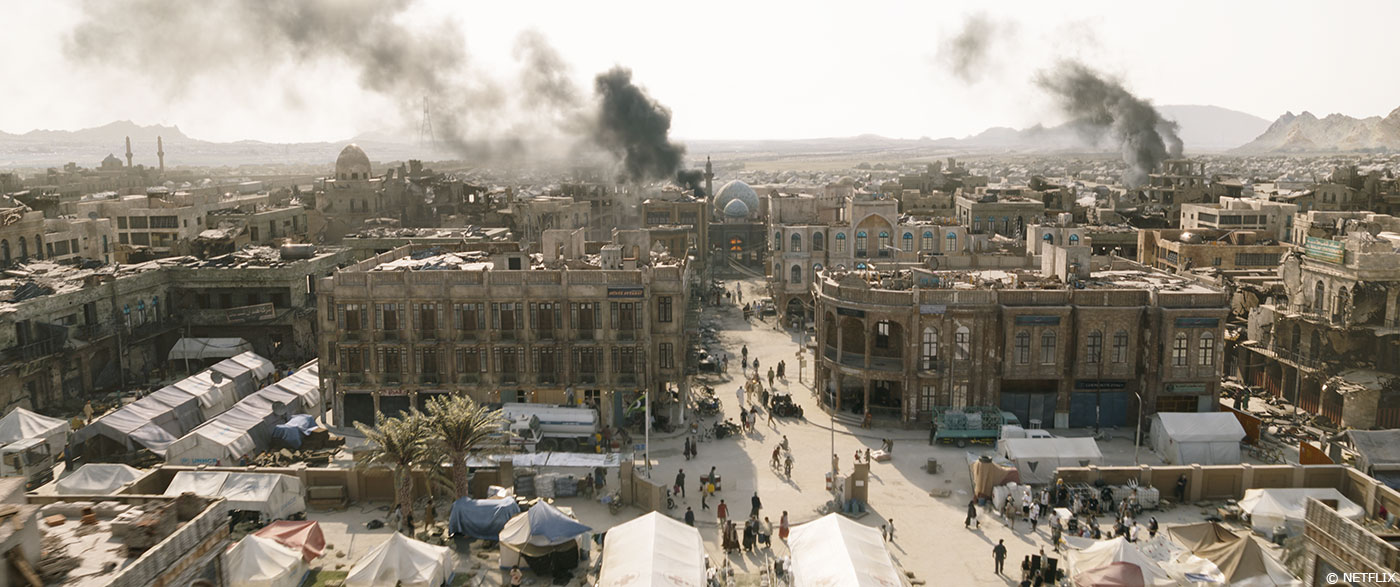In 2017, Richard Hoover explained the work of Framestore on BLADE RUNNER 2049. He won a Best Achievement in Visual Effects at the Academy Awards for this work. He then worked on DUMBO. Today he tells us about his work on 6 UNDERGROUND by Michael Bay.
How did you get involved on this show?
I met Michael just by chance on the Sony lot one day, he was coming out of a meeting and I was waiting for one. We chatted briefly and he said he had something I should read. His assistant called a few days later and I went by his office to read the work in progress script. The third act literally kept changing as I was reading through it. We chatted a little bit about the look of the film and I threw out the idea of all natural light, no process screens. We agreed that as much as possible the film would feel like he shot it live. Michael has so many camera tricks and methods up his sleeve that it was nearly possible.
What was your feeling to work again with director Michael Bay?
I have always seen things eye to eye with Michael, not really sure what it is, but I think it’s our common commercial director shooting mentality? I love watching him work, its crazy most of the time, but I see what he is going for and that makes it easy for me.
What was his expectations and approach about the visual effects?
We wanted a real look with his taste applied. He wants thing lit a very specific way which is his trademark style and he pluses everything with subtle additions that dirty up the shot and make the action feel exciting, entertaining and real at the same time.
How did you organize the work with your VFX Producer?
This show was very simple that way. Industrial Light & Magic was the sole vendor for production even though they subbed out some of the work. ILM also spread the work over their three studios, Singapore, Vancouver and San Francisco. Raynault and Scanline also did a good portion of the work, but through ILM financially.
How did you approach the Bayhem crazy action sequences?
I just supported Michael in any way I could to let him do his thing. It’s amazing to watch and be a part of it.
Can you elaborates about the impressive opening car chase sequence?
The execution was designed to use the historic locations and Michaels shooting style to set the bar for a car chase at the top. Greg Smerz was the stunt lead for the sequence and together they pulled off just about everything you see. We of course removed rigs and wires and added blood, bodies and debris in some cases. Again, It was about Michael shooting everything practically he could and VFX filling in or augmenting to complete his vision for the shot.
How did you work with the SFX and stunt teams?
In this film most of the practical work was through Michaels direction. I embraced as much smoke as he wanted to shoot with, it was part of the conceit to shoot as if there were no VFX. I did shoot some stunt elements to augment the car chase when the get dragged by his ankle in the car chase. Most of the stunt work we did was through digital stunt animation that augmented or manipulated what Michael shot. For example, we did roto the stunt men and re-animate their paths in the kitchen magnet scene while adding knives, pots/pan and food. And in a couple shots we did hook ups from digi doubles to the real stunt men. This was mostly because it was not possible to fly them far enough in the set.
Which stunt was the most complicated to enhance?
The magnet field and its effect on ships guards turned out to be the trickiest. Even though multiple stunt actors where rigged to fly across the ship, SFX had things on wires to fly on a path and projected food with air movers; while props just stood off frame and through things through the frame. It was an organized chaos for each shot. In the end, we had to add the historic port background, digi doubles and clean up the shot in pretty much every case. The good thing was with no green screens the natural lighting came out looking convincing right from the start.
The sequence is full of super slow-motion shots. How does that affects your work?
Not really a concern, Michael spoke to me about these moments as comedic beats to break up the film. Each one was a specific gag and I purposely addressed these early in the post schedule because they were integral to the pacing of the film.
How did you handle so many explosions and destructions in the historic city of Florence?
Well I didn’t really, they are for the most part real.
Another action sequence takes place on top of a Hong Kong Tower. How did you create this luxurious flat?
The entire apartment, all three floors, was built in a dirt field next to the Caltava stadium outside of Rome. We looked at a number of possible methods of execution for the set. Including building a 360? LED screen wall around it. Since the design was filled with reflective surfaces and surrounded by floor to ceiling glass walls, we wanted to keep as much of the reflections as possible. The decision to build the set next to the Caltrava architecture was pivotal to keeping a large portion of what was seen outside real. We added the city and extended the Caltrava construction 80 stories to make the apartment look high, but the idea was to mix real with CG so that there was never a 100% CG shot. We did use several LED screens for animated advertising as if mounted on buildings next door.
During the sequence, a swimming pool cracks and the water invades the place. Can you elaborates about the water creation and animation?
The pool was engineered to hold water, but on the completion of the set we found the glass end was bowing out too much from the water pressure. So for the entire sequence Scanline Munich filled the pool. They also, simmed the glass break and the initial water fall into the set. There after, SFX use three enormous silos of water and 1 foot hoses to cascade down the stairs into the floors below and wash the actors across the floor to the far side of the set. The approach was to create that action with real water and then augment the volume and actor interaction where needed. The shot of Melanie grabbing the mullion and kicking out the guard was a specific set piece outside the apartment and we extended the building and water volume into the CG Hong Kong background. The master drone shot with water falling from all the windows was primarily Scanlines work on the water and Raynault handled the Hong Kong extension.
How did you create and animate the various digital doubles?
ILM built doubles and handled the animation for all cases using on set photos on the actors. Scanline animated the doubles for the crowd being mowed down by the presidents drivers. There were a few face replacements on stunt doubles some of which where elements shot in London after principle was complete.
The final sequence involve a big yacht. How did you recreate it and sinks it in later in the movie?
The yacht was a combination of a real ship and a set for the back half only used for the magnet portion of the sequences. The real yacht in the plate was rotated and repositioned in a CG water extension to accomplish the sinking. The yellow magnet devices and the subsequent explosions where all designed by ILM Vancouver.
In the magnet sequence, a CG environment was used to replace the Rome landscape surrounding the set. As there was no green screens used, everything was roto’d and the on set lighting was preserved. Bojan, augmented the sun for the interiors as the glass was heavily tinted. We also experienced some extremely heavy rain while shooting this sequence so practical units where used to balance the sequence on dark rainy days.
Did you want to reveal to us any other invisible effects?
As I described earlier, much of the car chase is real yet enhanced to achieve Michaels vision. Some highlights are the motorcycle crashing into the Peugeot, partial real motorcycle and digi double animation. The forklift crash was a combination of prop fork and CG blades with CG seat, window and body penetration. CG animated Peugeot with digi doubles where in between real car shots on stage hitting sculptures. The set was only the floor and sculptures and the surrounding rooms where CG.
Can you tell us how you choose the various VFX vendors?
ILM made the choices based on past experience with the vendors.
Can you tell us more about your collaboration with their VFX supervisors?
We had a call everyday with Jason at ILM and included the vendor sup when their work was up for review. This process was especially interactive as we used Evercast as our video conference tool which allows spontaneous reviews within minutes of having something to show.
The vendors are all around the world. How did you proceed to follow their work?
One of the features of Evercast is that the sessions video and audio can be recorded with annotations. This allowed all the vendors to review the session on their own time as if they were there. If they had questions, we could open the review and clear things up anytime. When Michael was part of the reviews, we used the Cisco system from his location, home or at the office and used the Evercast camera to record the session.
Which sequence or shot was the most challenging?
The Hong Kong sequences and the yacht magnet effects where the most difficult.
Is there something specific that gives you some really short nights?
No not really. I think that I am not surprised by much at this point in my carrier. I look at everything as a challenge, solving problems both visually and fiscally to support the story is really fun for me.
What is your favorite shot or sequence?
There are many that turned out well, but I like the drone shots in Hong Kong especially the shot of Ben being chased up the roof of Caltrava.
What is your best memory on this show?
Seeing the approach and planning being executed through the process. I think the images we made look great and having the pieces come together is very satisfying.
How long have you worked on this show?
I started looking at the script in June of 2018 I think and I finished my part in October of 2019.
What’s the VFX shots count?
Good question, I believe we where about 350 big shots through ILM and venders and 400 through in house compositing.
What was the size of your team?
On the production side, it was Pat Sandston and myself. We did have a dedicated VFX editor or any coordinators on our side. ILM had two producers and several coordinators on their side.
What is your next project?
I am currently working on RED NOTICE with Rawson and Netflix.
A big thanks for your time.
WANT TO KNOW MORE?
Netflix: You can watch 6 UNDERGROUND on Netflix now.
Industrial Light & Magic: Dedicated page about 6 UNDERGROUND on ILM website.
© Vincent Frei – The Art of VFX – 2020




























